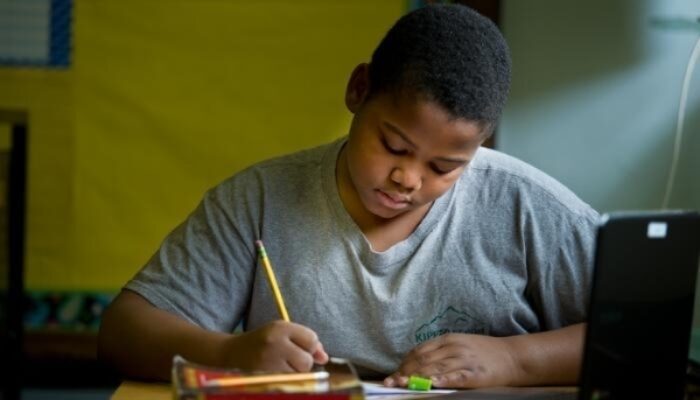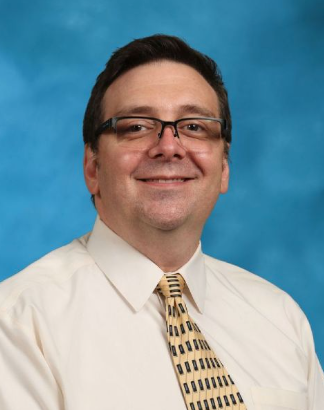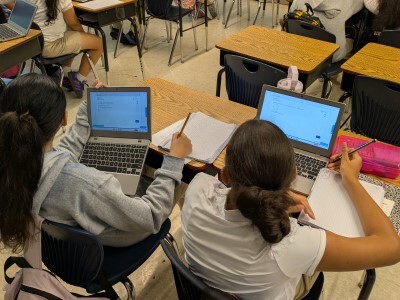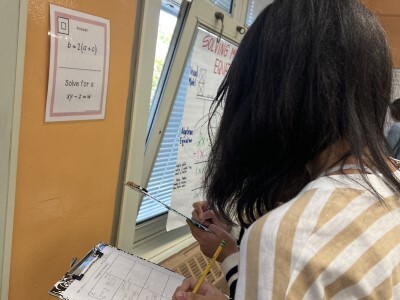It Really Is Possible to Reach Every Student
Topics

We’ve all had the experience of truly purposeful, authentic learning and know how valuable it is. Educators are taking the best of what we know about learning, student support, effective instruction, and interpersonal skill-building to completely reimagine schools so that students experience that kind of purposeful learning all day, every day.
Does blended, self-paced learning help students grow and develop competency? A middle school English action research study aimed to find out.
Several years ago, I realized that too many of my students were missing out on their instruction in my English class. Some because they were absent, others because the lessons weren’t keeping students’ attention, and some because I wasn’t differentiating well enough to reach all of my students. I started recording myself teaching during my first-period class, which was the beginning of what I considered to be great video lessons (I had no idea just how much I would learn later).
One day, I turned to one of my favorite podcasts and was excited to hear that it was about making a great screencast video. Since I had been creating video lessons already, I was ready to learn ways to make them even better. On this podcast, Kareem Farah, the CEO and co-founder of The Modern Classrooms Project, was explaining how to make videos that would keep my students’ attention. He explained that the videos should be short, engaging, and interactive. The videos that I had been creating were none of those things. I had been simply recording my entire 45-minute lesson while I was teaching. I rarely showed my face in my video, and there was nothing for the students to “do” while they watched it. But, as Maya Angelou says, “Do the best you can until you know better. When you know better, do better.” I was definitely going to do better with my instructional videos! My journey into video lessons just became a journey through a blended, self-paced, mastery-based classroom.
The podcast recommended a free course over blended, self-paced, mastery-based teaching, so I jumped into it. I tried my hand at using the model with a partial writing unit at the end of the 2020-2021 school year. Students turned in their thesis for me to check and could not continue until this part was approved, then they moved to the rest of their introduction, then their body paragraphs, and so on. If a student turned in something that would have scored below a 3 on a 4-point rubric, I required them to make revisions. Some students just needed to know that they did a part wrong, other students needed some one-on-one time to work through a part of the writing. Using this model, I was able to sit with a student for 5-10 minutes to get them started, then check in with others and come back to my student who I was working with. I was able to truly differentiate my instruction as I needed on the spot.
My journey into video lessons just became a journey through a blended, self-paced, mastery-based classroom.
The final essays that the students turned in were so much better than they had been in the past. I was so impressed with how much the students’ writing improved from previous essays that I decided to implement this new model for the next school year. I was already enrolled in graduate school working toward my masters of science in curriculum and instruction and decided that this model would be the theme of my research project. I had seen research on self-pacing, mastery-based grading, and blended learning, but there was not much research on using all three strategies together. That was my goal.
In November, I began collecting data for my research project, which focused on students developing competency in a unit about analyzing fiction through nonlinear plot. I had been using this instructional model since the beginning of the school year, so students weren’t new to learning in this new way. We started our unit with a pre-test, then spent about six days in the unit, and ended with a post-test. In this unit, students watched an instructional video that I recorded using a screencasting program and embedded questions in it to guide students through taking their notes. Students then had a practice assignment where they used the skills they just learned. After completing that assignment, students took a short quiz that assessed their mastery of the concept. If students did not show mastery on the quiz, they had a reteach session with me. After the reteach, students then took a different form of the mastery check quiz. If they showed mastery, they moved on to the next lesson.
I had 73 of the 120 students in my classes who participated in my research study. Seven students were identified as SPED (special education) and five were ELL (English language learners). At the end of this unit, I saw growth in almost every subset of my students. The greatest growth came in our SPED students, who grew from a 59 percent average on the pre-test to a 94 percent average on the post-test. All students grew an average of 16 percent from pre- to post-test. Many of my SPED students needed some extra time with me for re-teaching and because of this model of instruction, they were able to get the extra help they needed. This is especially important since SPED students are often one of the most underserved groups of students. Their growth was absolutely amazing to see!
This is an example of one of my video lessons on characterization, which students access on Edpuzzle.
Now, I would love to say that this model of teaching was a magic bullet, but that is not what it is intended to be. I have had to teach some students how to manage their time. I have had to help students learn how to regulate their technology use. A few students wanted to go back to the old way of doing things because change is always hard. One student even went to complain to my principal. Fortunately, my principal is in love with this method and explained that I am using best practices by self-pacing and requiring mastery. (By the way, just last week, after they have started actually doing the work, this student told me that I was their favorite teacher!) However, I have continually revised my own work, shortened my videos, worked on making sure that due dates weren’t unreasonable, and even decided what materials were really important for students to show their understanding. These changes helped me make sure that all of my students are able to be successful using this model. Based on the results of my research study, I am convinced that this model is the best way to truly meet the needs of every student, even if they don’t realize it!
If you are looking for ways to reach every student in your classroom, I am convinced that using a mastery-based, self-paced, blended learning method is the best way to truly make this happen effectively. If you are on the fence, jump off and give this a try. If something doesn’t work, revise it and try again. Eventually, you will show mastery at it. Besides, isn’t that what we want our students to do?
Photo at top courtesy of NGLC.




